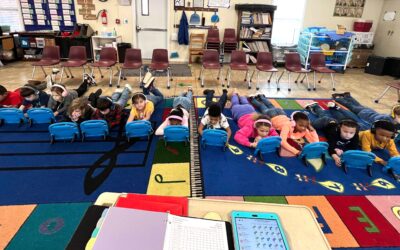However, digital literacy is an ecosystem of skills that are nuanced and interconnected, which makes assessing it challenging. To simplify, this article shares a planning approach that uses four criteria to refine the assessment, examples of this approach in action, and other best practices.
Four Criteria of Digital Literacy Assessment
Adapted from Harald Gapski’s (2007) research, the following are four criteria to optimize digital literacy assessments: level of analysis, context of usage, object of measuring, and perspective method.
Gapski’s approach helps to hone the design of assessments so they yield actionable data. By using these criteria, educators are more targeted in their goal setting, development or purchase of an assessment and analysis of the data and its application.
1. Level of Analysis
The level of analysis defines the extent of reporting to be addressed by the digital literacy assessment. Assessments report for levels like an individual student, classroom or small group of students, grade band or school level, and even a district more generally. Essentially, the level of analysis identifies who will be measured.
2. Context of Usage
The context of usage notes the purpose of the assessment. Is the digital literacy assessment…
- trying to benchmark a student’s understanding of a concept or skill?
- measuring attainment of material after a lesson?
- gauging the effectiveness of new curriculum?
- quantifying student readiness for online assessments?
Knowing the context helps clarify the assessment’s intent.
3. Object of Measuring
The object of measuring deduces the different skills addressed in a digital literacy assessment based on the data needed to answer the above questions. For example, objects of measuring could include typing speed and accuracy, formatting a table in excel, explaining the problem-solving process involved in computational thinking, or identifying instances of cyberbullying.
These specific skills can be determined using standards alignment in curriculum. By boiling down the context of usage into the measurable elements, the assessment takes shape.
4. Perspective Method
The perspective method determines the type of assessment that would best fit the above three criteria. Gapski posits four methods for assessing digital literacy:
- Self-Observation. Self-observation refers to students analyzing their own comprehension and sharing their perspective with the teacher, often occurring through surveys. This can be both a diagnostic and formative assessment.
- External Observation. External observation, or teacher observation, analyzes student comprehension based on classroom interactions and performance. This can also be both a diagnostic and formative assessment.
- Qualitative Assessment. Qualitative assessment reveals details and depth of information to help educators understand the results’ full implications. Qualitative assessment often takes the form of projects and portfolios and are typically summative assessments.
- Quantitative Assessment. Quantitative assessment provides numbers that cover a broad perspective of study. Quantitative assessments are comprehensive and usually facilitated as summative assessments and standardized tests with multiple choice, true/false, and other questions designed to have explicitly correct and incorrect answers.
This approach brings value to a digital literacy assessment by ensuring it is actionable for the right stakeholder in the correct context. The level of analysis tells us what context of usage to apply. The object of measuring refines the context to determine the specific digital literacy skills that will be assessed. And, finally, the perspective method tells the optimal mode for the digital literacy assessment based on the other criteria.
Examples of Digital Literacy Assessments
1. Individual Student External Observation
A teacher wants to assess whether a new student in class (level of analysis) understands how to use a spreadsheet (context of usage) before diving into a project-based unit that will require spreadsheet skills. Specifically, the project will require the student to know how to import data into a spreadsheet, make a table, and create a bar graph (object of measuring). To best assess this skill diagnostically, the teacher will observe (perspective method) the new student during a brief practice assessment at the beginning of the unit.
2. Classroom Self-Observation
A teacher plans to assess their classroom’s (level of analysis) understanding of cyberbullying (context of usage) after the most recent online safety lesson. The teacher intends to measure whether students know how to recognize cyberbullying, intervene, and report instances of it (object of measuring). Because of the personal nature of these skills, the teacher will facilitate the formative assessment through a student survey (perspective method) to allow students to reflect and analyze their sentiments and where they feel confident and not.
3. Grade Band Qualitative Assessment
A tech coordinator wants to assess seventh graders across the district (level of analysis) to gauge the effectiveness of the new computational thinking and coding curriculum (context of usage). The assessment will target students’ ability to articulate the different elements of the coding process and leverage it to create different programs (object of measuring) through putting together presentations to be shared with younger students (perspective method).
4. District-Wide Quantitative Assessment
Finally, district leaders are seeking to assess whether students across the district (level of analysis) have the requisite technology skills to perform well on online assessments (context of usage) because the state recently adopted this format. They will analyze whether typing speed, knowledge of basic screen navigation, and word processing skills (object of measuring) impact student performance based on data comparing performance on the computer-based standardized test (perspective method).
Following this approach empowers educators, from classroom teachers to administrators, to develop digital literacy assessment that enhances curriculum.
Additional Best Practices for Assessing Digital Literacy
While intentionally planning digital literacy assessments to ensure that the results are relevant, actionable, and informative, there are other important elements to consider. Below are three best practices to optimize digital literacy assessments.
- Align to standards. As with any other assessment, it is important to align digital literacy assessments with standards. What are these standards? Check out this article for three sets that are commonly used in digital literacy curriculum.
- Use an interactive tool. Paper-based assessments cannot capture the nature of digital literacy skills. Technology-enhanced questions will lead to a more authentic digital literacy assessment.
- Remember the “digital literacy” in “digital literacy assessment.” Be considerate that the assessment should focus on digital literacy, rather than a skill like reading comprehension, for example. This means that the reading level of a digital literacy assessment should be low enough that it does not hinder students’ ability to demonstrate their digital literacy skills.
A Prerequisite, Tool and Learning Objective
Gapski writes: “As a key competence, digital literacy is crucial…a prerequisite, as a tool and as a learning objective for living in an IT-enriched world.”
Gapski not only sees digital literacy as a factor for success in academics or employment but also in determining quality of life. He recognizes that digital literacy is critical to students’ success in the increasingly digital world. And to tell whether students have developed or are developing these skills requires assessment.
Final Thoughts
Digital literacy assessment completes digital literacy curriculum by allowing educators to gauge efficacy, optimize instruction and resources, and measure student progress. The quality of student learning and attainment of digital literacy skills depends on these intentional assessments.

Learning.com Team
Staff Writers
Founded in 1999, Learning.com provides educators with solutions to prepare their students with critical digital skills. Our web-based curriculum for grades K-12 engages students as they learn keyboarding, online safety, applied productivity tools, computational thinking, coding and more.
Further Reading
Guide to Teaching Algorithms in Computer Programming for K-12 Students
Algorithms are the heart of computer programming, providing the step-by-step instructions that computers follow to perform tasks and solve problems....
Technology Skills to Teach Gen Z for Future Success
Gen Z and Gen Alpha will enter a workforce that looks very different than the one their parents and grandparents experienced. Educators know it’s...
Digital Skills for North Carolina Students
In our district, like most others, the use of digital learning tools has catapulted since the pandemic. With students online more than ever, it’s...




